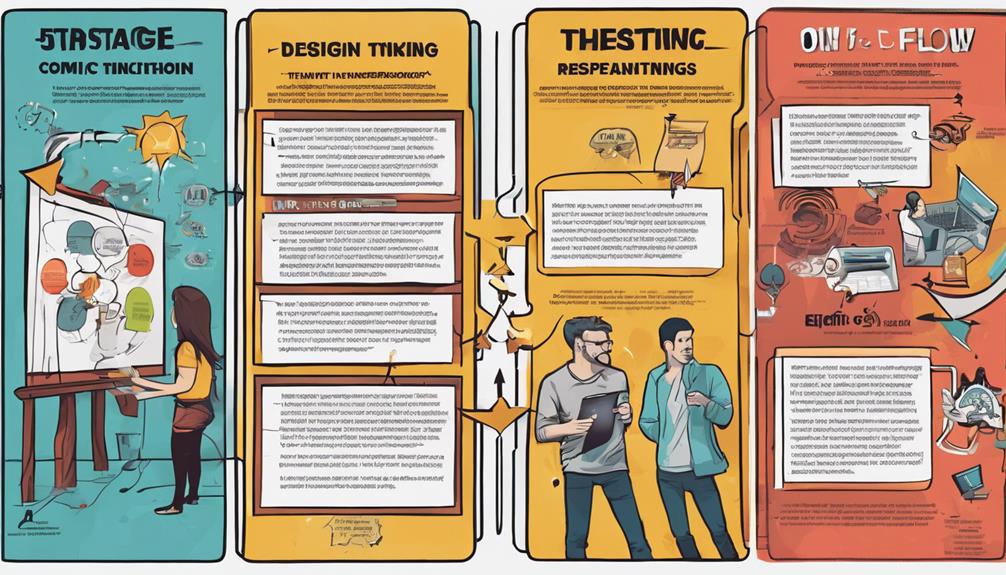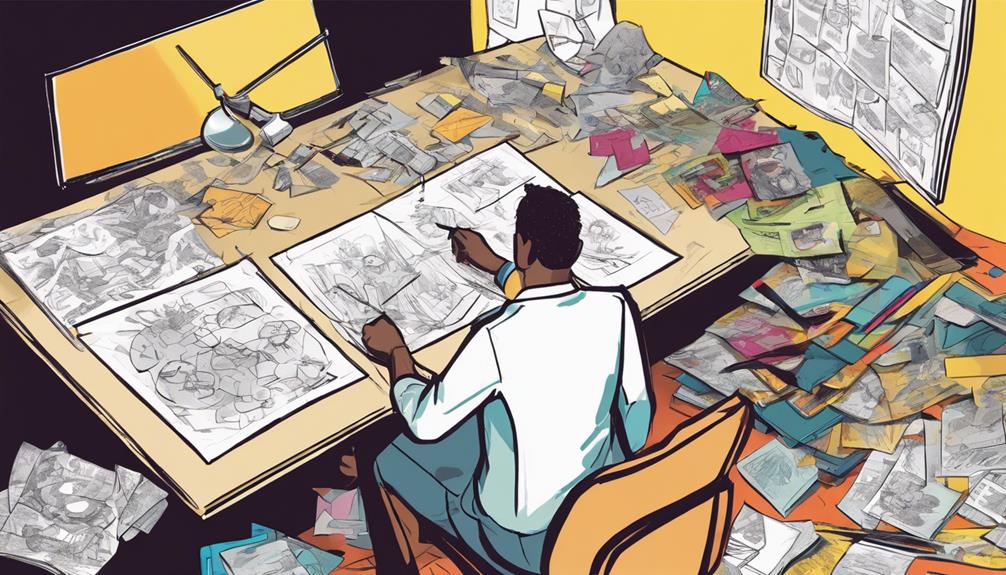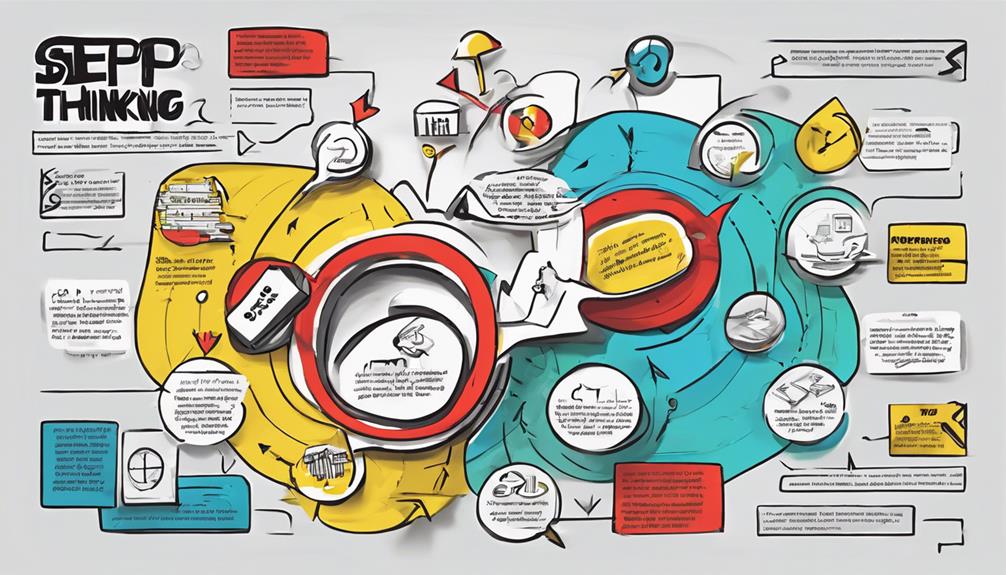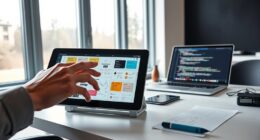Discover the Design Thinking framework, a user-focused method that boosts innovation and problem-solving. It centers around Empathize, Define, Ideate, Prototype, and Test stages. With a human-centered approach, you'll delve into understanding user needs, solving core problems, brainstorming creative solutions, and testing prototypes. Explore how this framework enhances collaboration, creativity, and user satisfaction in various industries. Get ready to plunge into a structured approach that drives innovation and competitiveness.
Key Takeaways
- Understanding the stages: Empathize, Define, Ideate, Prototype, Test.
- Applying human-centered design principles: Inclusivity, Diversity, Iterative Prototyping, Collaboration, User involvement.
- Core activities: User Research, Problem Framing, Ideation, Prototyping, Testing.
- Implementation process: Prototype integration, Testing, Refining solutions based on feedback.
- Goal and application: Problem understanding, Idea generation, Prototyping, Testing, Diverse industry applications.
Overview and Importance
Design thinking's significance lies in its ability to provide a structured approach for understanding user needs and generating innovative solutions to complex problems. This problem-solving methodology emphasizes empathy and collaboration, allowing teams to explore deeply into user experiences.
The process consists of five key stages: Empathize, Define, Ideate, Prototype, and Test. By following these stages, companies harness the power of design thinking to drive innovation and remain competitive in the market.
Through design thinking, organizations like Google, Apple, and Airbnb have revolutionized their industries by putting user needs at the forefront of product development. By fostering a culture of empathy and creativity, these companies consistently deliver solutions that resonate with their target audiences.
This approach not only ensures that products are desirable and meet user expectations but also considers technological constraints and business objectives, making the solutions feasible and viable in the competitive market landscape.
Human-Centered Design Principles

To truly embody the essence of user-centricity in your design process, it's crucial to adhere to Human-Centered Design Principles. Human-Centered Design emphasizes inclusivity, diversity, and user involvement throughout the design process. By incorporating these principles, designers make certain that the final products cater to a wide range of users and address their unique needs effectively.
Here are some key aspects of Human-Centered Design Principles:
- Inclusivity: Making certain that all individuals, regardless of background or abilities, can use the product.
- Diversity: Recognizing and embracing the varied perspectives and experiences of users.
- Iterative Prototyping: Testing and refining solutions through multiple iterations to enhance usability.
- Collaboration: Working together across disciplines to create user-friendly products that address complex societal challenges.
Design Thinking Framework Stages

You're about to explore the key stages of the Design Thinking framework, each playing a vital role in the innovation process.
These stages, including Empathize, Define, Ideate, Prototype, and Test, guide you through understanding user needs, defining problems, generating creative ideas, building prototypes, and testing solutions.
Design Thinking Process Overview
The Design Thinking process unfolds through a series of stages aimed at fostering innovation and user-centered solutions.
- Empathize: Understanding the users' needs and challenges through research and observation.
- Define: Defining the core problem based on insights gathered during the empathize stage.
- Ideate: Generating a wide range of creative ideas to solve the defined problem.
- Prototype: Creating tangible representations of ideas to test and gather feedback from users.
This iterative process allows teams to refine and improve their solutions based on user feedback. By prioritizing empathy, creativity, and iterative development, Design Thinking enables teams to create innovative and user-centric solutions. Design Thinking workshops often leverage this process to guide participants through each stage, encouraging collaboration and fostering a deep understanding of the problem at hand.
Through this structured approach, teams can navigate the complexities of design challenges with a user-focused mindset.
Key Elements in Framework
Moving forward from the stages outlined in the Design Thinking Process Overview, the Design Thinking Framework comprises five essential stages that form the foundation for innovative problem-solving.
The stages of the Design Thinking process include Empathize, Define, Ideate, Prototype, and Test. In the Empathize stage, teams immerse themselves in the user's experience to understand their needs deeply.
Following this, the Define stage involves clearly defining the problem statement based on insights gathered. Ideate encourages creative brainstorming to generate a wide range of potential solutions.
The Prototype stage involves creating tangible representations of ideas for testing and validation. Finally, in the Test stage, prototypes are evaluated with users to gather feedback and refine solutions.
Throughout these stages, collaboration, a user-centric approach, and a focus on problem-solving are key elements that drive the Design Thinking Framework, enabling teams to create innovative solutions that truly meet user needs.
Core Activities and Tools
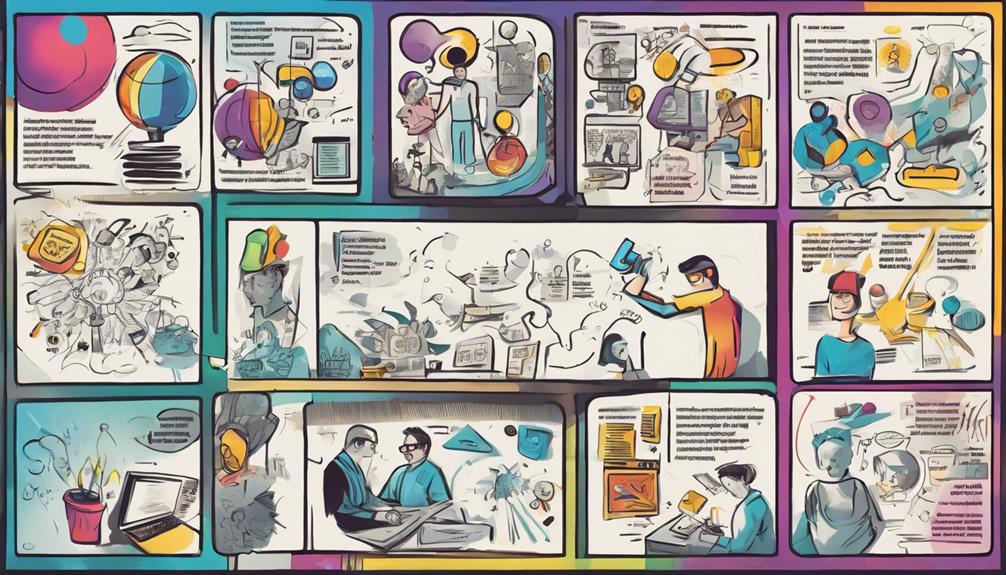
Within the Design Thinking framework, essential activities and tools play a pivotal role in guiding teams through the innovation process. Here are some key core activities and tools that are integral to the Design Thinking process:
- User Research: Understanding the needs, desires, and behaviors of the end-users through observation, interviews, and surveys.
- Problem Framing: Defining the challenge or opportunity in a human-centered way to make sure the focus remains on the user.
- Ideation: Generating a wide range of creative solutions through brainstorming sessions and other ideation techniques.
- Prototyping and Testing: Building quick, low-fidelity prototypes to gather feedback from users and iterate on the proposed solutions.
Implementation and Testing
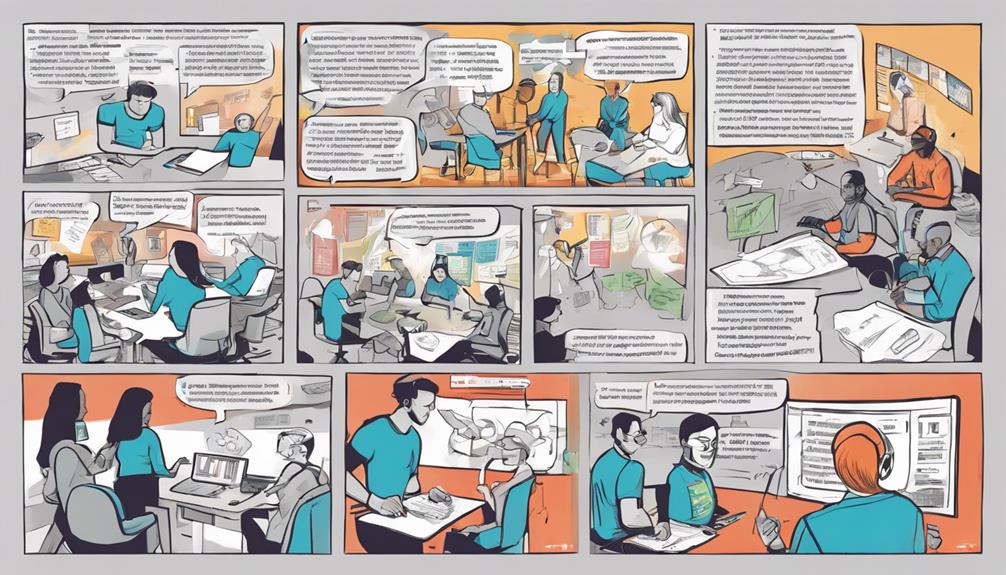
To proceed with the Design Thinking process, the next step involves implementing and testing the prototype to gather valuable feedback for refinement.
Prototype integration is vital at this stage, as it allows teams to merge the proven prototype with the current landscape seamlessly. Testing plays a significant role in this phase, where feedback from users and stakeholders is collected to refine solutions effectively.
Core activities during this phase include testing for impressions and risks, as well as refining solutions based on the received feedback.
Implementing Design Thinking not only optimizes prototypes based on research learnings but also accelerates idea generation within a short timeframe. Successful testing ensures that the solutions meet user requirements efficiently, leading to a more user-centric design.
However, it's essential to be mindful of the testing risks and continuously iterate to enhance the prototype based on the testing impressions gathered.
Goal and Application
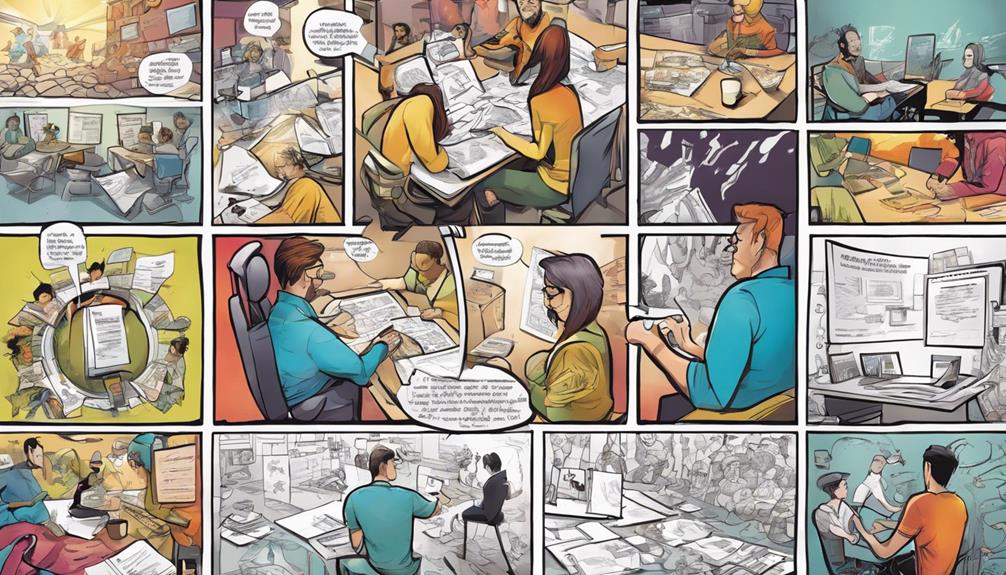
With a focus on comprehending user needs and preferences, the Design Thinking framework aims to create innovative solutions. This human-centered design approach is widely applicable in various industries, driving customer satisfaction through its iterative stages and team collaboration.
Here's how Design Thinking achieves its goal and application:
- Understanding the Problem: Design Thinking starts by empathizing with users to define the problem accurately.
- Generating Ideas: Teams ideate creative solutions based on the insights gathered, fostering a culture of innovation.
- Prototyping and Testing: Through rapid prototyping and testing, the framework guarantees user experience optimization and solution effectiveness.
- Application in Diverse Industries: From startups to established companies, Design Thinking is utilized to drive customer satisfaction and create impactful solutions that meet user needs across different sectors.
Frequently Asked Questions
What Is the Design Thinking Framework?
Design Thinking Framework is a structured, iterative process for creatively solving complex problems. It includes stages like Empathize, Define, Ideate, Prototype, and Test, focusing on understanding user needs, defining problems, generating ideas, prototyping solutions, and testing them.
What Is the Complete Design Thinking Process?
To understand the complete Design Thinking process, start with empathy to define user needs, then ideate, prototype, and test solutions. This human-centered approach fosters innovation by iterating based on feedback, enabling effective problem-solving and user-centric design.
What Are the 4 Phases in a Design Thinking Framework?
To understand the 4 phases in a design thinking framework, first explore Empathize for user needs. Define pinpoints core problems, Ideate sparks creative solutions, while Prototype brings ideas to life for testing. Explore deeply and innovate!
What Is the 5 Stages in Design Thinking?
To understand the 5 stages in design thinking, start by empathizing with users to uncover needs. Define the core problem statement based on research. Ideate creative solutions through brainstorming. Prototype ideas for testing. Finally, test and iterate for feedback.
Conclusion
So there you have it – the complete design thinking framework laid out for you in all its glory!
Now you can impress your colleagues with your newfound knowledge of human-centered design principles and core activities.
Just remember, when implementing and testing your ideas, don't forget to actually listen to real people and their feedback.
Good luck revolutionizing the world one design at a time!
